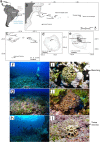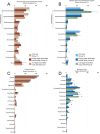Baseline Assessment of Mesophotic Reefs of the Vitória-Trindade Seamount Chain Based on Water Quality, Microbial Diversity, Benthic Cover and Fish Biomass Data
- PMID: 26090804
- PMCID: PMC4474894
- DOI: 10.1371/journal.pone.0130084
Baseline Assessment of Mesophotic Reefs of the Vitória-Trindade Seamount Chain Based on Water Quality, Microbial Diversity, Benthic Cover and Fish Biomass Data
Abstract
Seamounts are considered important sources of biodiversity and minerals. However, their biodiversity and health status are not well understood; therefore, potential conservation problems are unknown. The mesophotic reefs of the Vitória-Trindade Seamount Chain (VTC) were investigated via benthic community and fish surveys, metagenomic and water chemistry analyses, and water microbial abundance estimations. The VTC is a mosaic of reef systems and includes fleshy algae dominated rhodolith beds, crustose coralline algae (CCA) reefs, and turf algae dominated rocky reefs of varying health levels. Macro-carnivores and larger fish presented higher biomass at the CCA reefs (4.4 kg per frame) than in the rhodolith beds and rocky reefs (0.0 to 0.1 kg per frame). A larger number of metagenomic sequences identified as primary producers (e.g., Chlorophyta and Streptophyta) were found at the CCA reefs. However, the rocky reefs contained more diseased corals (>90%) than the CCA reefs (~40%) and rhodolith beds (~10%). Metagenomic analyses indicated a heterotrophic and fast-growing microbiome in rocky reef corals that may possibly lead to unhealthy conditions possibly enhanced by environmental features (e.g. light stress and high loads of labile dissolved organic carbon). VTC mounts represent important hotspots of biodiversity that deserve further conservation actions.
Conflict of interest statement
Figures








References
-
- Wessel P, Sandwell DT, Kim S-S. The global seamount census. Oceanography. 2010;23(1):24–33. 10.5670/oceanog.2010.60 - DOI
-
- Etnoyer PJ, Wood J, Shirley TC. BOX 12-How large is the seamount biome? Oceanography. 2010;23(1):206.
-
- Shank TM. Seamounts: deep-ocean laboratories of faunal connectivity, evolution, and endemism. Oceanography. 2010;23(1):108–22. 10.5670/oceanog.2010.65 - DOI
-
- Slattery M, Lesser MP, Brazeau D, Stokes MD, Leichter JJ. Connectivity and stability of mesophotic coral reefs. Journal of Experimental Marine Biology and Ecology. 2011;408(1‚Äì2):32–41. 10.1016/j.jembe.2011.07.024 - DOI
-
- Lesser MP, Slattery M, Leichter JJ. Ecology of mesophotic coral reefs. Journal of Experimental Marine Biology and Ecology. 2009;375(1–2):1–8. 10.1016/j.jembe.2009.05.009 - DOI
Publication types
MeSH terms
LinkOut - more resources
Full Text Sources
Other Literature Sources

